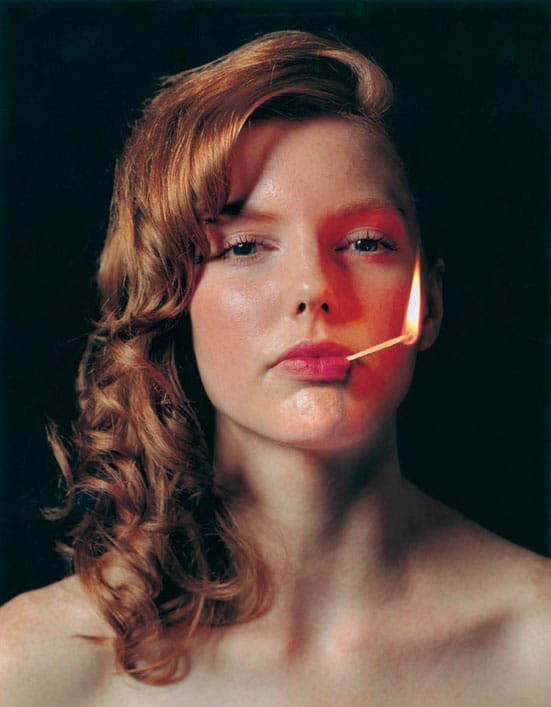6th October 2006 — 4th November 2006
Jeez. Nothing as likely to bring
me out all Daily Mail as an exhibition
such as this. Yet it is hard to
write about, because, although
much of the work is so hideous
as to defy belief, disconcertingly,
the very next pieces might be things
of curious exploratory beauty.
It strikes me that Saatchi might
be suffering from a kind of visual
bi-polarity in the way he buys,
because [in my humble opinion]
much of what he has collected is
awful cobblers: shallow, sloppy
and poorly executed. And he has
collected it. In previous centuries,
a collector, a connoisseur, bought
items as an indication of his/her
rarefied sensibility. One moved
through the country pile getting
a sense of the owner’s life
and travels and acculturation.
But in Saatchi’s case, one
doesn’t sense that these
works do anything other than move
from storage area to exhibition
space. Which I think, shifts the
connection between the owner and
his collection to something more
dispassionate, less interested,
which shows in the profusion of
deliberately ugly work. Few pieces
bear lingering over well. Many
one scurries from, as they are
just too revolting or irritating.
It is as though he has moved towards
an insanely recherché way
of buying, which encompasses work
by artists like Albert Oehlen,
the ‘champion’ of ‘bad’ painting,
currently exhibiting at the Arnolfini.
As though he’s looking for
the mote to put in his eye, gravel
to mix in his granola, for work
that exudes ennui and self-revulsion.
The outstanding example of this,
a piece that made me very bloody
angry at the time – it still
makes my toes curl and want to
dig my nails into my palms until
they bleed – is a painting
by Daniel Hesidence, ‘Painting
R.A.M.’ I can’t even
bring myself to describe it. I
think it’s the ugliest painting
I’ve ever seen. If it’s
still making me feel nauseous,
it must be good, I suppose, I just
hate it, not least for the nasty
lazy brushwork and colouring. Peculiar
territory for an artist to choose
to inhabit. And there seemed to
be a general consensus that poor
execution was in some sense a ‘comment’:
Elliott Hundley’s inarticulate
collage, Aleksandra Mir’s
big vapid marker pictures (the
combined waste of time of so many
anonymous technicians), Ryan Trecartin’s
grotesquely chaotic and lurid papier
mâché Art-Brut style ‘World
Wall’, and, though I assume
such was his intention, Jules de
Baillancourt’s naïve
art style paintings often looked
careless, adding to an overall
sense of scrappiness pervading
the show.
But in the middle of this there
was some great stuff: Kristin Baker’s
large collages of Formula One racing
cars smashing into verges, bits
of expensive high-tech metal flying
off in a rush of chaos are from
her memories of going to races
with her father as a child and
you get that sense of pure excitement
in the spectacle of danger and
destruction unmediated by any concern
for the survival of the driver.
Dan Colen’s squat wall collage
was playful and crafty, and the
idea that Rama Lama Ding Dong,
a bit of graffiti sprayed on some
MDF, was something Saatchi actually
paid money for, must hearten every
struggling trendy artist. And Dana
Schultz’s lurid canvases
are funny on the messy business
of being a horrible teenager, with
one huge purple reclining male
nude, who manages to be simultaneously
majestic and hilarious.
Matthew Day Jackson’s ‘American
Odyssey’ feels like a
riddle: a wall of pictures
of sphinxes with knitted heads,
doctored images of defining
moments in American history,
architectural drawings and
religious pastiches (though
one can never be sure in America);
it felt like a well-crafted
cryptic clue, but I was beaten.
Gerald Davies’s canvases
were superb, the much-talked
about ‘paedophilic’ painting
feels genuinely searching and
quietly confessional, despite
its large size, due I think
to its secretive palette, and
his pink and green teenage
girly scat fantasy written
in a Beyoncé diary is
only brilliant; I was smitten.
Florian Maier-Aichen’s
photographs were oases of precision,
using heavy inks to exaggerate
the heavily urbanised Californian
coastline and the poisoning
of the wilderness. Serendipitously,
the last piece, Adam Cyanovic’s
large, pale-blue triptych, ‘Love
Poem (ten minutes after the
end of gravity)’, is
a dreamy meditation on the
end of America painted in ‘Flashe
and housepaint on Tyvek’,
its pastel slatted wood houses,
Pontiacs, fridges filled with
fluo foodstuffs, motels, Pringles,
Coke, nylon nighties, palmy
fronds, all uprooted and floating
away, to make you think how
we would miss the whole mess
if it suddenly wasn’t
there.
FMH
Royal Academy of Arts
Burlington House
Piccadilly
London W1J 0BD
http://www.royalacademy.org.uk/
Open
Daily, 10am-6pm
Late night Friday until 10pm

Josephine Meckseper
Pyromaniac
2, 2003
C - Print 101 x 76cm
Courtesy
of The Saatchi Gallery, London. © The
artist, 2006 Royal Academy of Arts